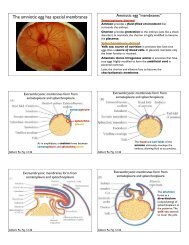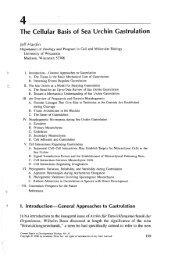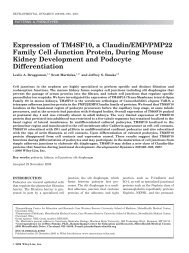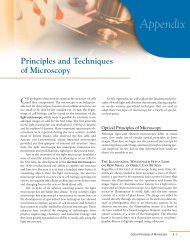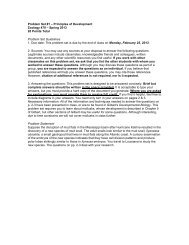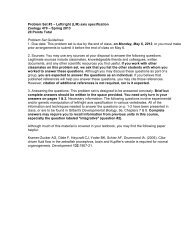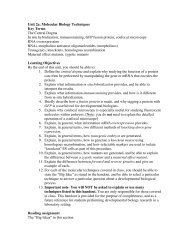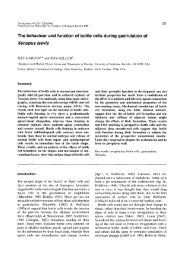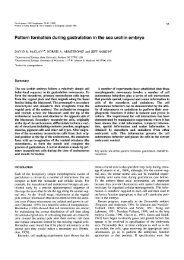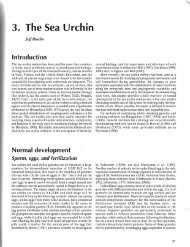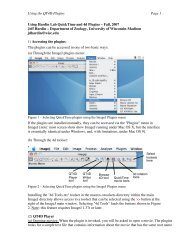EPIGENETIC SIGNALS AT GASTRULATION IN TIIE SEA URCHIN ...
EPIGENETIC SIGNALS AT GASTRULATION IN TIIE SEA URCHIN ...
EPIGENETIC SIGNALS AT GASTRULATION IN TIIE SEA URCHIN ...
You also want an ePaper? Increase the reach of your titles
YUMPU automatically turns print PDFs into web optimized ePapers that Google loves.
254 McClay et aI.<br />
and foregut at the end of gastrulation. In the inhibited embryos, these<br />
markers fail to be expressed. However, if the blocks to matrix contact are<br />
removed, invagination begins, goes to completion, and Endo 1 and Ecto V<br />
are expressed in the correct sequence. Thus presumptive endoderm requires<br />
some kind of interaction with the extracellular matrix for archenteron<br />
formation to begin. Ifthe inhibitors are added after invagination begins, the<br />
ftrst phase of elongation proceeds to completion, but the ftnal elongation<br />
and attachment of SMCs to the target often fail to occur (Butler et aI., 1987;<br />
Hardin and McClay, in preparation). In these embryos Endo 1 and Ecto V<br />
are expressed in sequence even though the tip of the archenteron has failed<br />
to reach the target region (Hardin and McClay, in preparation).<br />
Many SMCs remain undifferentiated during invagination and appear to<br />
remain undifferentiated until after their behavior changes as a result of<br />
coming into contact with the animal pole target Experimentally, this<br />
conclusion was reached based on the ability of SMCs to convert to become<br />
primary mesenchyme cells throughout much of the invagination process<br />
(Ettensohn and McClay, 1988). The lineage conversion capability is a<br />
property of a subset of SMCs since pigment cells differentiate from SMCs<br />
during invagination and were not observed to convert to the PMC lineage<br />
(Gibson and Burke, 1985; Ettensohn and McClay, 1988). The precise time<br />
at which SMCs lose their competence to become PMCs is unknown. It can<br />
be observed, however, that differentiation of these cells into muscle or<br />
coelomic pouch does not occur until after the target event at the end of<br />
gastrulation. Thus, at some time following target recognition, which itself<br />
may involve contact with the extracellular matrix, SMCs become restricted<br />
with respect to lineage and begin to differentiate.<br />
We have shown that once initiated, differentiation within the archenteron<br />
is largely autonomous. During the process of invagination cells rearrange, a<br />
sequence of genes are expressed, and the primitive gut elongates.<br />
Secondary mesenchyme cells then help to complete the process of<br />
invagination, and their contact with a site that is anatomically related to the<br />
region of the future mouth somehow signals the completion of invagination.<br />
Once this target is reached the SMCs then begin to differentiate. Thus<br />
morphogenesis of the sea urchin embryo involves a combination of both<br />
genetically programmed and epigenetically regulated cell differentiation and<br />
gene expression.<br />
REFERENCES<br />
1. Adelson, D.L. and Humphreys, T. (1988). Sea urchin<br />
morphogenesis and cell-hyalin adhesion are perturbed by a monoclonal<br />
antibody speciftc for hyalin. Development 104, 391-402.<br />
2. Alliegro, M.C., Ettensohn, c.A., Burdsal, C.A., Erickson, H.P., and<br />
McClay, D.R. (1988) Echinonectin: a new embryonic substrate adhesion<br />
protein. 1. Cell Bioi. 107, 2319-2327



